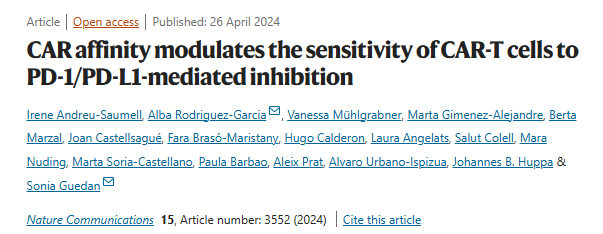
Lusine Hovhannisyan: How the affinity of CAR T cells for their target antigen influences their sensitivity to this suppression
Lusine Hovhannisyan, Co-Founder of ArmBionics, Assistant Doctor at Insel Group, shared a post on LinkedIn:
“A recent publication on CAR T cells affinity by Sonia Guedan and collaborators in Nature Communications.
Cracking the Code: How CAR T Cell Affinity Affects Immune Suppression in Solid Tumors!
CAR T cell therapy for solid tumors faces a major challenge: immune suppression through the PD-1/PD-L1 pathway. A new study explored how the affinity of CAR T cells for their target antigen influences their sensitivity to this suppression, shedding light on why some treatments may succeed while others falter.
By comparing CAR T cells with low-affinity (LA) and high-affinity (HA) for HER2 in preclinical models, researchers found that LA CAR T cells are more vulnerable to PD-L1-mediated inhibition.
However, CRISPR/Cas9 knockout (KO) of PD-1 significantly boosted the cytokine secretion, polyfunctionality, and antitumor efficacy of LA CAR T cells while reducing exhaustion-related gene signatures. Interestingly, HA CAR T cells remained unaffected by PD-1 KO, indicating inherent resistance to PD-L1 inhibition.
The study also revealed that co-stimulation matters: CAR T cells with 4-1BB signaling were less sensitive to PD-L1 inhibition, even at low antigen affinity, compared to those using CD28 or ICOS.
These findings suggest that tailoring CAR T cell affinity and modifying PD-1/PD-L1 pathways could optimize therapies, offering new hope for effective treatment of solid tumors.”
CAR affinity modulates the sensitivity of CAR-T cells to PD-1/PD-L1-mediated inhibition
Authors: Irene Andreu-Saumell et al.

-
ESMO 2024 Congress
September 13-17, 2024
-
ASCO Annual Meeting
May 30 - June 4, 2024
-
Yvonne Award 2024
May 31, 2024
-
OncoThon 2024, Online
Feb. 15, 2024
-
Global Summit on War & Cancer 2023, Online
Dec. 14-16, 2023
